When a man was cleaning up an abandoned wood factory near his house, he suddenly heard some faint cries coming from a nearby corner.
After looking around the place, the man saw a little pup hiding something. Upon further inspection, he realized that the cries were actually coming from her babies as she had just given birth!
The man, seeing that the mama dog wasn’t doing too well, immediately contacted animal rescuers and informed them of the situation.
Help Is On The Way
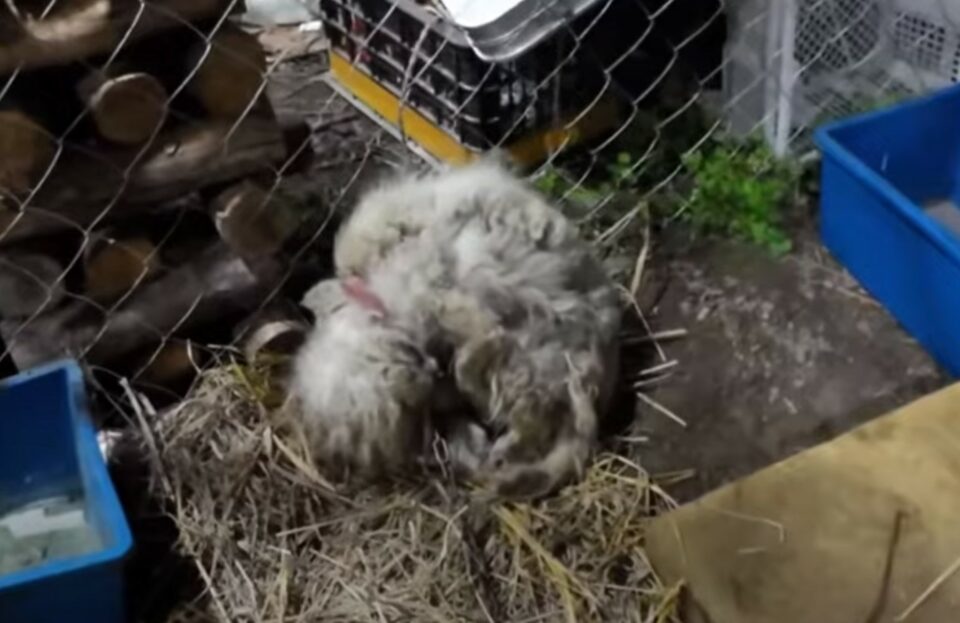
When rescuers arrived, it was clear to them that this little family really needed his help.
The mama wasn’t looking too good. She was extremely malnourished and had overgrown and tangled fur. However, the worst part was that she had a chain around her neck, preventing her from finding food for her babies.
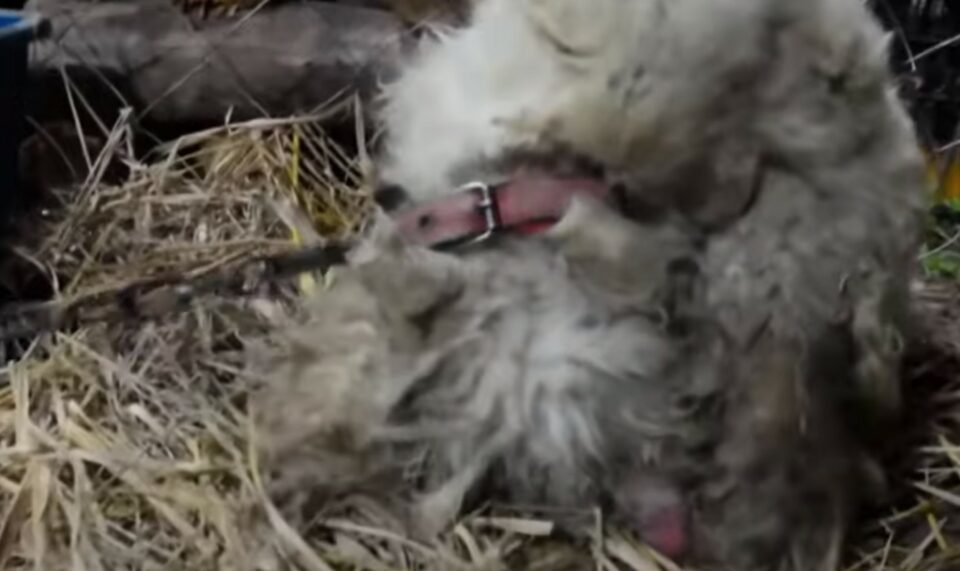
The rescuer couldn’t bear to see her in such a condition outside in the cold, so he quickly grabbed a box, lined it with grass, and carefully placed her babies inside it before unchaining her.
But, the Mama dog didn’t trust the hooman, and because he didn’t want to startle her, the rescuer decided to let her get to know them a bit more before moving her and her babies.
Starting a little fire, he sat next to her and started speaking to her in a calm and soothing voice, trying to win over her trust.
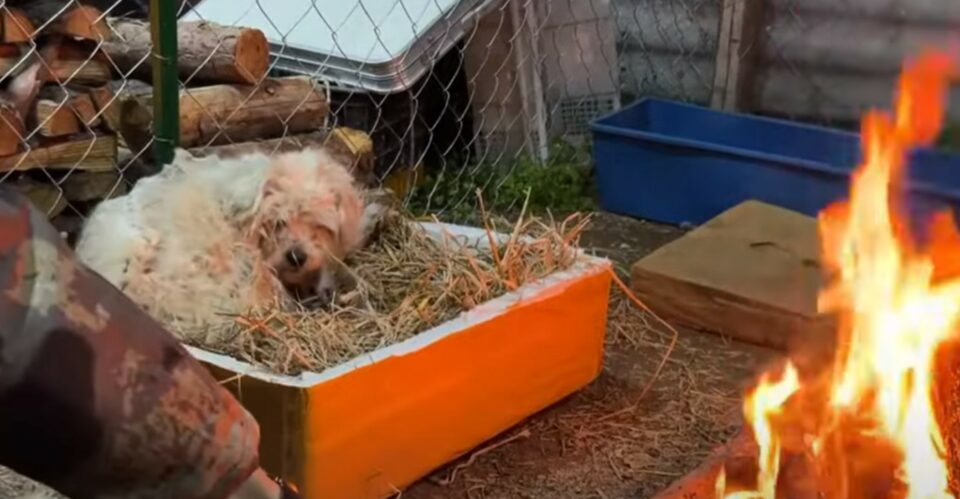
The rescuer realized that the babies were extremely hungry, and after checking her up, he realized that the mama dog wasn’t giving any milk because she was starving.
He immediately ran to the store to buy some food so that she could fill up her belly and she could finally be able to feed her pups. And, as soon as he placed some kibble into a bowl, she heard the yummy food, ran to it, and started eating.
After finishing her meal, she ran back into the box and lay next to her children, allowing them to eat as well.
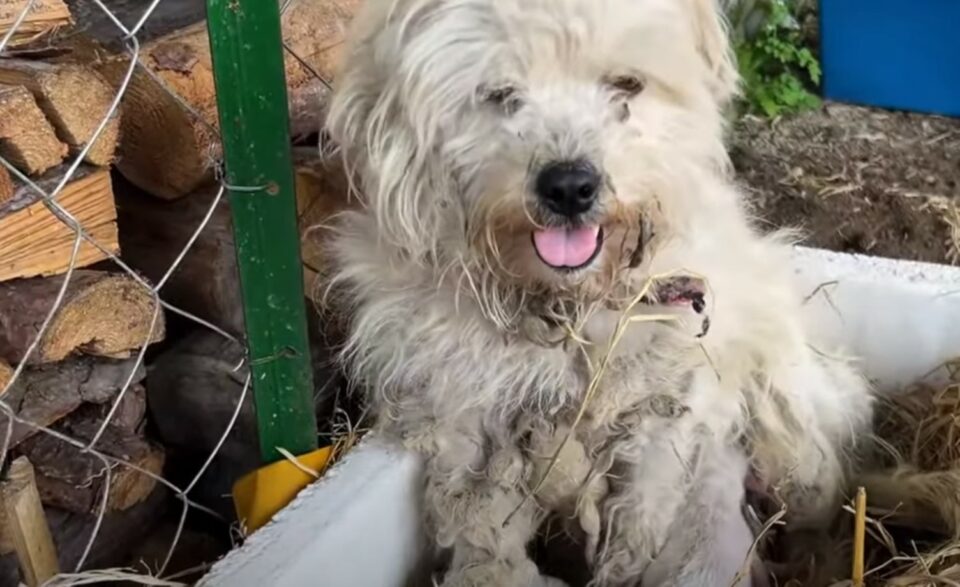
Even though the rescuer thought that she would finally trust him, the mama dog still seemed anxious and refused to leave. The rescuer respected her wishes, made a fire that would keep them warm the entire night, and promised to come back in the morning.
Never Give Up
When the determined hooman came back the next morning, the mama dog greeted him with a huge smile on her face.
As he set up her breakfast, she ran to enjoy her meal, allowing the man to check up on her babies.
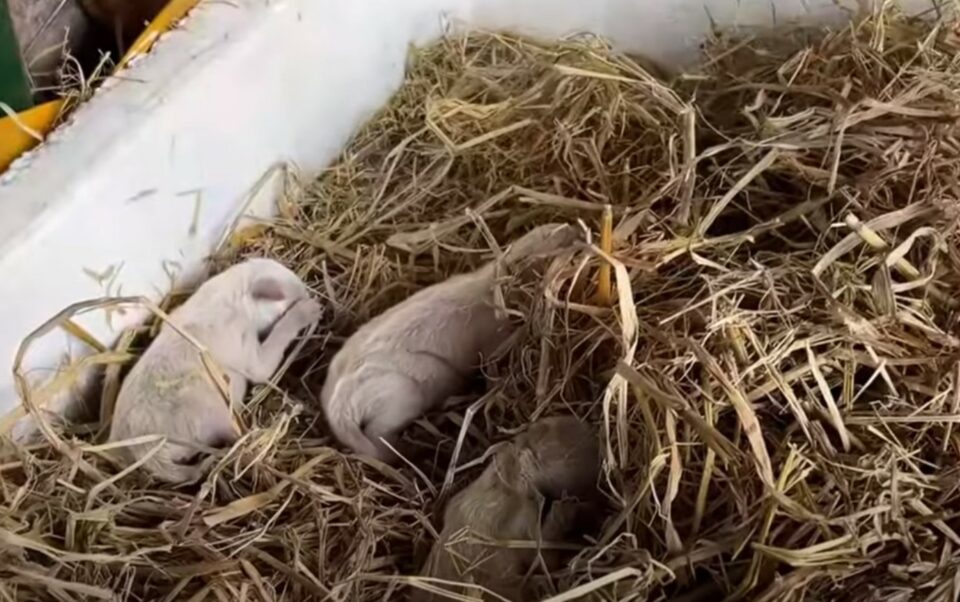
Unfortunately, he was left heartbroken. Only one of the four puppies had made it through the night.
Hoping to keep it alive, the rescuer decided to bring the puppy home with him and provide it with proper care.
When they got home, he gathered all the supplies he needed and began feeding it multiple times throughout the day, ensuring that it had everything it needed to grow up big and strong.
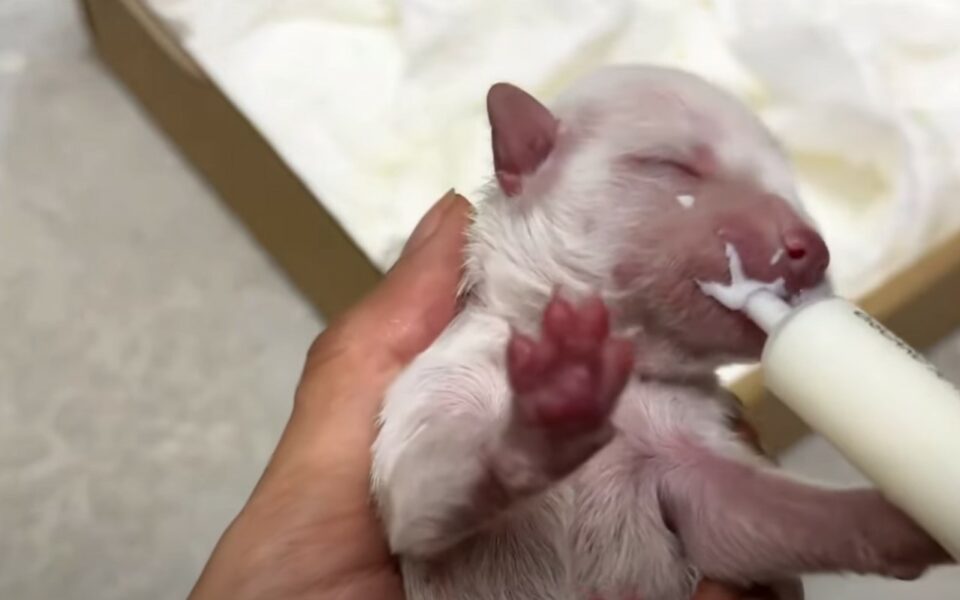
After one week, the pup began to grow and was able to visit his mama who stayed at the wood factory. And, as soon as the two met again, she embraced her baby and, because she also got so much better, started to nurse it.
Seeing that she was finally healthy enough to care for her child, the man decided that the puppy was safe again with her mother and that he no longer had to take it home.
But, he still came back every single day to bring them food and make sure that they had everything they needed.
New Chapter
As time passed, the mama dog’s trust in the hooman grew bigger and bigger. She finally allowed him to take her and the puppy away from the factory and into his warm and loving home.
The man was overjoyed, and he happily prepared everything!
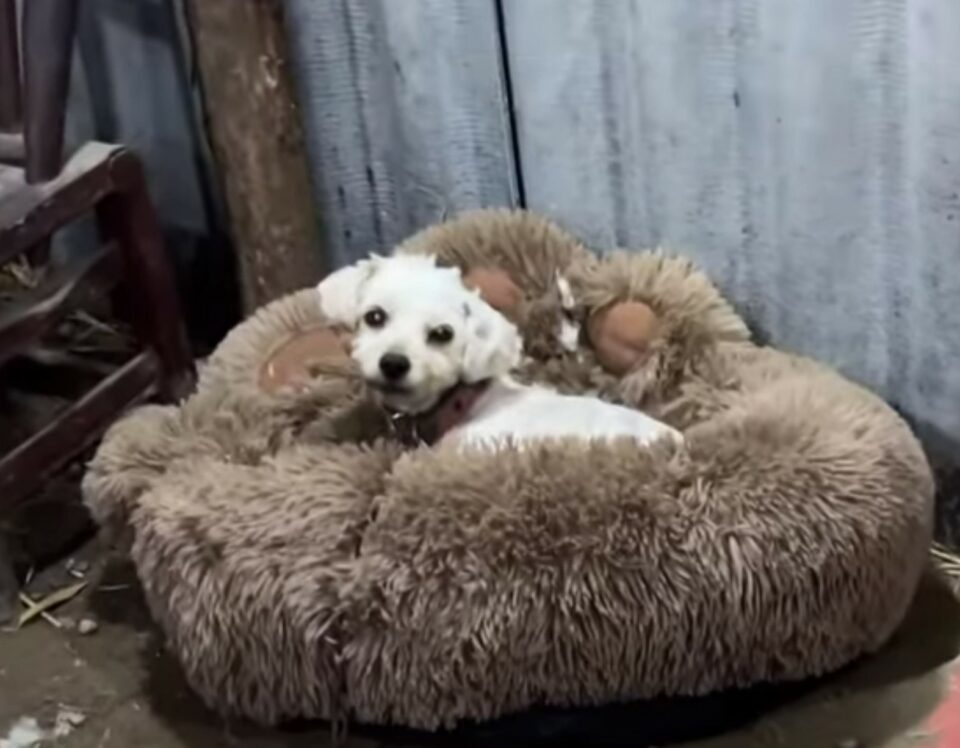
Five weeks later, the rescuer came across an abandoned litter of puppies whom he had to bring home with him. At first, he wasn’t really sure if the mama and her puppy would like their new guests, but after some time, they all became super close!
The four new puppies loved playing with the puppy and the mama dog would happily watch over them.
It wasn’t long before she adopted all four of them, which meant that she now had five adorable puppies!
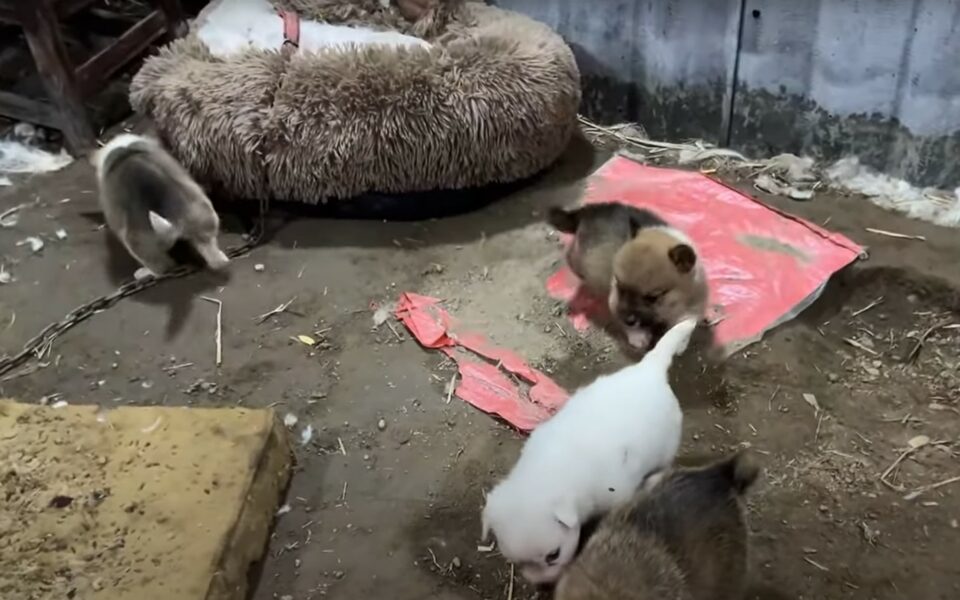
In no time, this incredible litter grew up big and strong, and the hooman, as well as their mama, couldn’t be happier.
I am sure that, once the time is right, each and every one of these pups will find a loving forever home that will give them a life full of fun, joy, and love. But, for the time being, they will remain with this incredible hooman who truly saved their lives.
Ever noticed your furry companion dragging their bottom across the floor? It might seem odd or even amusing, but dogs scooting their butts is a common behavior with various reasons behind it. As a seasoned dog trainer, you’ve probably encountered this quirky habit more than once and wondered about its significance.
When it comes to our beloved four-legged friends, their actions often speak volumes. Butt scooting is not just a random behavior; it can signal underlying issues that need attention. Understanding why dogs engage in this peculiar activity is essential for their well-being and your peace of mind. So, let’s unravel the mystery behind this curious canine behavior together.
Understanding the Scooting Behavior in Dogs
What Is Scooting?
Scooting is when your dog drags their bottom along the floor or ground. This behavior can look amusing at first glance, but it’s usually a sign that something might be bothering your furry friend. Dogs scoot by sitting on their rear end and pulling themselves forward using their front legs. It’s commonly seen in dogs but can indicate a potential issue that needs attention.
The Anatomy Behind the Action
The reason dogs scoot their butts can be linked to various factors. One common cause is anal gland issues. Dogs have small sacs near their anus that can become full or impacted, leading to discomfort and the urge to scoot. Other reasons include worms, skin irritation, or even issues with the anal area. It’s essential to pay attention to this behavior and consult with your vet to address any underlying problems promptly.
Remember to observe your dog’s scooting behavior closely as it could be a signal of a more significant health concern. Regular vet check-ups and maintaining good hygiene practices for your furry companion can help prevent discomfort and identify any potential issues early on.
Common Reasons Dogs Scoot Their Butts
Anal Gland Issues
When your dog scoots, it could signal anal gland issues. Dogs have anal glands that can get blocked or infected, causing discomfort. These glands are located on either side of the anus and may need to be expressed by a veterinarian to alleviate the problem.
Intestinal Parasites
Intestinal parasites like worms can also be a reason for scooting behavior in dogs. Worm infestations can lead to itching and irritation around the rear end, prompting your furry friend to scoot to find relief. Regular deworming is crucial to prevent this issue.
Irritated Skin or Allergies
If your dog has irritated skin or allergies, they may scoot to relieve the itchiness. Skin conditions or allergies can affect the anal area, making scooting a way for dogs to ease the discomfort. It’s essential to address any skin issues promptly.
Anal or Rectal Problems
Scooting can be a sign of anal or rectal problems in dogs. Issues like infections, tumors, or injuries in the anal or rectal area can cause your dog to scoot. A thorough examination by a veterinarian is necessary to diagnose and treat these underlying concerns.
Diagnosing the Underlying Cause
Vet Examination: What to Expect
When you bring your furry friend to the vet to address their scooting behavior, the veterinarian will typically start by conducting a thorough physical examination. This examination may involve checking the anal gland area for any signs of inflammation, infection, or blockage. Your vet may gently palpate the area to assess if there’s any discomfort or abnormality. They might also inspect your dog’s skin for any signs of irritation, redness, or lesions that could be contributing to the scooting behavior. By examining your dog closely, the vet aims to identify any visible issues that could be causing your dog’s discomfort.
Possible Diagnostic Tests
To pinpoint the exact underlying cause of your dog’s scooting, the vet may recommend specific diagnostic tests. These tests can vary depending on the suspected issue but may include fecal analysis to check for intestinal parasites like worms. Your vet might also suggest testing the anal gland secretions to assess their quality and determine if they need expressing or if there’s an infection present. In some cases, further tests such as skin scrapings or blood work may be necessary to rule out allergies or systemic conditions contributing to the scooting behavior. By performing these diagnostic tests, the vet aims to gather the information needed to provide an accurate diagnosis and develop an appropriate treatment plan for your beloved pet.
Treatment Options for Scooting
When it comes to treating your dog’s scooting behavior, there are several options available depending on the underlying cause. Here are some common treatment approaches to help address the issues that may be leading to this uncomfortable behavior:
Addressing Anal Gland Problems
Anal gland problems are a common cause of scooting in dogs. Your vet may need to manually express the anal glands to provide relief to your furry friend. In some cases, if there is an infection or impaction, a course of antibiotics or anti-inflammatory medication may be prescribed to help alleviate the issue.
Treating Parasitic Infections
If intestinal parasites are the culprit behind your dog’s scooting, deworming treatment is essential. Your vet may recommend specific deworming medication based on the type of parasites identified through fecal analysis. Ensuring your dog stays on a regular deworming schedule can help prevent future infestations.
Remedies for Skin Irritation and Allergies
Skin irritation or allergies can also lead to scooting behavior in dogs. Your vet may suggest treatments such as medicated shampoos, topical ointments, or oral medications to address skin issues. Identifying and eliminating potential allergens from your dog’s environment can also help prevent recurring skin problems.
Surgical Interventions
In more severe cases where underlying issues like tumors or anatomical abnormalities are causing scooting, surgical interventions may be necessary. Your vet will discuss the surgical options available based on the specific diagnosis to provide long-term relief for your dog.
By addressing the root cause of your dog’s scooting behavior and following the recommended treatment plan provided by your vet, you can help your furry companion find relief and improve their overall well-being. Remember, early detection and prompt veterinary care are essential in ensuring your dog’s health and happiness.
Preventing Future Scooting Issues
Regular Grooming and Health Checks
Keeping your furry friend clean and healthy is essential in preventing future scooting episodes. Regular grooming helps in maintaining your dog’s hygiene by keeping the anal area clean and reducing the risk of skin irritation. Checking your dog’s anal glands during baths or grooming sessions can also help detect any issues early on.
Diet and Nutrition for Anal Gland Health
A balanced diet plays a crucial role in your dog’s anal gland health. Ensure your dog’s diet includes enough fiber to promote regular bowel movements, which can help naturally express the anal glands. Adding fiber-rich foods like pumpkin or incorporating specialized diets recommended by your vet can aid in preventing anal gland problems.
Parasite Prevention Tips
Parasites can be a common trigger for scooting behavior in dogs. To prevent parasitic infections, ensure your pet is on a regular deworming schedule as advised by your veterinarian. Additionally, using preventive measures such as flea and tick treatments can help keep parasites at bay, reducing the chances of scooting due to parasitic infestations.
By integrating these preventive measures into your furry companion’s routine, you can help minimize the likelihood of future scooting incidents and promote their overall well-being. Remember, early detection and proactive care are key in maintaining your dog’s health and happiness.
When to Seek Veterinary Help
Recognizing the Signs of Serious Conditions
If your dog continues to scoot their butt even after you’ve taken preventive measures, it could be a sign of a more serious underlying issue. Look out for symptoms like excessive scooting, red or swollen anal area, foul smell, or any signs of discomfort. These could indicate a need for prompt veterinary attention.
The Risks of Delaying Treatment
Delaying veterinary help when your dog is scooting excessively can lead to complications. Ignoring the issue may result in worsening of the underlying condition, causing discomfort or pain for your pet. Seeking timely treatment can help address the root cause of the scooting and ensure your dog’s health and well-being.
Conclusion
So, there you have it – the reasons why your furry friend might be scooting their butt. Remember, taking care of your dog’s anal health is crucial for their overall well-being. Regular grooming, checking their anal glands, a fiber-rich diet, and deworming can all help reduce those uncomfortable scooting episodes. But if you notice any concerning signs like excessive scooting, redness, or a funky smell, don’t hesitate to seek help from your vet. Timely intervention is key to addressing any underlying issues and ensuring your pup stays happy and healthy. Your dog’s comfort is worth it, so stay vigilant and give them the care they need.
Frequently Asked Questions
Why do dogs scoot their butts?
Dogs may scoot their butts due to anal gland issues, parasites like worms, skin irritation, or rectal problems. It’s important to consult a vet for proper diagnosis and treatment.
How can I prevent my dog from scooting its butt?
Regularly groom your dog to prevent hair matting, check the anal glands for impaction, ensure a balanced diet with fiber for regular bowel movements, and deworm your dog as advised by the vet to reduce scooting.
When should I seek veterinary help for my dog’s scooting behavior?
If preventive measures don’t stop the scooting or if you notice excessive scooting, redness, foul smell, or signs of discomfort, consult a vet promptly. Delaying treatment can worsen underlying issues, causing discomfort for your pet.
[no_toc]

Hey there, I’m Janet Brooks, a dog-loving student from California. I’m all about helping pups in need, especially those without homes. Me and my awesome friends work together to give shelter and love to stray dogs. Oh, and I also write blogs about dogs to share helpful info.